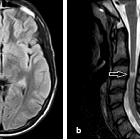relapsing remitting multiple sclerosis

Cerebellum
and brain stem volume loss in relapsing remission multiple sclerosis by MRI volumetry: relation to neurological disability score and number of relapses. A 29-year-old male patient with RRMS, EDSS score of 2, and a relapse rate of 2, complaining of sensory and pyramidal dysfunction. Axial and sagittal Flair sequences (a–c) showed multiple plaques of high SI seen at both parietal lobes; in periventricular white matter, pericallosal areas and centeum semiovale. The periventricular plaques are perpendicular to the ventricle giving Dawson’s finger appearance. 3D T1WI in sagittal view (d, e) for brain stem segmentation and in coronal view (f, g) for cerebellar white and grey matter segmentation; (d, f) raw unprocessed T1W image, (e, g) 3D T1 image after processing with 3D Slicer with colored segmented brain stem and cerebellum. The brain stem and cerebellar segmentation results showed the following data: midbrain 5.82 (N 5.24–6.33 cm3), pons 12.83 (N 12.66–16.51 cm3), medulla 3.87 (N 4.25–5.12 cm3), whole brain stem 22.52 (N 22.46–28.10 cm3), left cerebellar white matter 23.47 (N 19.06–25.21 cm3), left cerebellar grey matter 83.94 (N 84.39–102.17 cm3), right cerebellar white matter 22.82 (N 18.55–25.54 cm3), and right cerebellar grey matter 83.16 (N 84.36–101.87 cm3). Patient with EDSS score of 2 and a relapse rate of 2 had a moderate decrease in the volumes of the medulla and cerebellar grey matter bilaterally

Cerebellum
and brain stem volume loss in relapsing remission multiple sclerosis by MRI volumetry: relation to neurological disability score and number of relapses. A 25-year-old female patient aged 25 years old with RRMS, EDSS score of 0.5, and a relapse rate of 1, complaining of pyramidal dysfunction. Axial and sagittal Flair sequences (a–c) showed multiple plaques of high SI seen at both parietal lobes; in periventricular white matter, pericallosal areas right deep white matter (basal ganglia). 3D T1W images in sagittal view (d, e) for brain stem segmentation and in coronal view (f, g) for cerebellar grey and white matter segmentation; (d, f) raw unprocessed T1W image, (e, g) 3D T1image after processing with 3D Slicer with colored segmented brain stem and cerebellum structures. The brain stem and cerebellum segmentation results showed the following data: midbrain 5.9 (N 5.24–6.33 cm3), pons 13.85 (N 12.66–16.51 cm3), medulla 3.63 (N 4.25–5.12 cm3), whole brain stem was 23.38 (N 22.46–28.10 cm3), left cerebellar white matter 24 (N 19.06–25.21 cm3), left cerebellar grey matter 84.59 (N 84.39–102.17 cm3), right cerebellar white matter 23.7 (N 18.55–25.54 cm3), and right cerebellar grey matter 84.5 (N 84.36–101.87 cm3). Patient with EDSS score of 0.5 and a relapse rate of 1 had a mild decrease in the volume of the medulla oblongata only

Cerebellum
and brain stem volume loss in relapsing remission multiple sclerosis by MRI volumetry: relation to neurological disability score and number of relapses. A 35-year-old female patient with RRMS, EDSS score of 4, and a relapse rate of 6, complaining of visual problems, cerebellar dysfunction, bowel, and bladder dysfunction. Axial and sagittal Flair sequences (a–c) showed multiple plaques of high SI at both parietal lobes; in periventricular white matter, pericallosal and callosomarginal areas, juxtacortical junction, and centeum semiovale. The periventricular plaques are perpendicular to the ventricle giving Dawson’s finger appearance. 3D T1W images in sagittal view (d, e) for brain stem segmentation and in coronal view (f, g) for cerebellar grey and white matter segmentation; (d, f) raw unprocessed T1W image, (e, g) 3D T1image after processing with 3D Slicer with colored segmented brain stem and cerebellum structures. The brain stem and cerebellum segmentation results showed the following data: midbrain 5.02 (N 5.24–6.33 cm3), pons 11.7 (N 12.66–16.51 cm3), medulla 3.1 (N 4.25–5.12 cm3), whole brain stem 19.82 (N 22.46–28.10 cm3), left cerebellar white matter 19.42 (N 19.06–25.21 cm3), left cerebellar grey matter 76.57 (N 84.39–102.17 cm3), right cerebellar white matter 20.61 (N 18.55–25.54 cm3), and right cerebellar grey matter 76.07 (N 84.36–101.87 cm3). Patient with EDSS score of 4 and a relapse rate of 6 had a minimal decrease in the volume of the midbrain, severe decrease in the volumes of the pons, medulla, whole brain stem, and cerebellar grey matter bilaterally
relapsing remitting multiple sclerosis
Siehe auch:

 Assoziationen und Differentialdiagnosen zu relapsing remitting multiple sclerosis:
Assoziationen und Differentialdiagnosen zu relapsing remitting multiple sclerosis:

